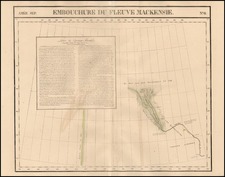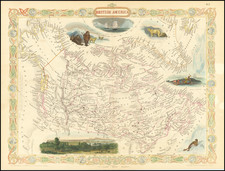Rare Variant Edition!
Heavily hand annotated variant edition of D'Anville's map of Canada, first published in Paris in 1755.
Variant State
D'Anville's Canada Louisiane et Terres Angloises . . . is normally found as a 4-sheet map, covering most of North America. However, this separately issued example, unlike others, is complete in two sheets, with a solid neatline across the bottom, unlike all other examples of the map which we have examined.
Handwritten Annotations
Segmented and laid on linen, the present example also includes extensive hand written notes in a contemporary hand, which we date to almost certainly the first decade of the 19th Century, in part because it was acquired with a second map dated 1802 with annotations in what appears to be the same hand.
The map includes 2 sets for boundaries between what would become the French and British parts of North America and later the United States, one in blue and a faint line in pink, the latter of which likely shows the French claims prior to the Seven Years War (French & Indian War).
The additions are interspersed throughout the map and demonstrate the work of a keen and studied observer. The most extensive annotation is the extension of the Mississippi River and its tributaries to the north, ending with a larger "L. de la Tou?lnalle." To the east, "le grande portage" is noted. On the northeast coast of Lake Superior and in several places south of Hudson Bay, the names of a number of Hudson Bay Company factories and forts are listed, including Brunswick, Gloucester and Fort de la Souris", along with "factorie de L'est" at the far northeast coast of Hudson Bay.
West of the Great Lakes, B. Verte (Green Bay), and several Portages and settlements are noted.
In the north of Lac Huron, the short-lived English Fort on St. Joseph's Island is noted.
In the area of the St. Jean River, Fredericks Town, Ste. Anne and Nouvelle Brunswick have been added.
In the far northeast of the map, Detroit de Belle Isle, C de Grat, and Bona-Vista are added.
General Map Content
The map provides exceptional early detail along the lower portion of the Missouri (alternately the "Pekitanoui") and the upper waters of the Mississippi. The Keweenaw peninsula is named as Kiaonan, and Isle Royale is called I. Minong. The area is filled with scores of Indian tribes and villages named and located.
As noted by map scholar R.V. Tooley
To illustrate the cartography of the second half of the eighteenth century, a d'Anville map is essential. He dominated not only French but all contemporary geographers. He was one of the foremost to leave blank spaces in his maps where knowledge was insufficient ... His representation of the Great Lakes is superior to that of his contemporary, John Mitchell.
D'Anville's map would become the basis for numerous future mappings, most notably by Jeffereys and Sayer & Bennett.
Rarity
The map, as a 2 sheet map with neatline, is apparently unrecorded.
Jean-Baptiste Bourguignon d’Anville (1697-1782) was one of the foremost French geographers of the eighteenth century. He carried out rigorous research in order to create his maps, which greatly developed the technical proficiency of mapmaking during his lifetime. His style was also simpler and less ornate than that of many of his predecessors. It was widely adopted by his contemporaries and successors.
The son of a tailor, d’Anville showed cartographic prowess from a young age; his first map, of Ancient Greece, was published when he was only fifteen years old. By twenty-two, he was appointed as one of the King’s géographes ordinaire de roi. He tutored the young Louis XV while in the service to the Crown. However, royal appointment did not pay all the bills, so d’Anville also did some work for the Portuguese Crown from 1724. For example, he helped to fill out Dom João V’s library with geographical works and made maps showing Portugal’s African colonies.
D’Anville disapproved of merely copying features from other maps, preferring instead to return to the texts upon which those maps were based to make his own depictions. This led him to embrace blank spaces for unknown areas and to reject names which were not supported by other sources. He also amassed a large personal map library and created a network of sources that included Jesuits in China and savants in Brazil. D’Anville’s historical approach to cartography resulted in magnificently detailed, yet modern and academic, maps. For example, his 1743 map of Italy improved upon all previous maps and included a memoir laying out his research and innovations. The geographer also specialized in ancient historical geography.
In 1773, d’Anville was named premier géographe de roi. In 1780, he ceded his considerable library to the Ministry of Foreign Affairs to be used for as a reference library for diplomats. D’Anville is best known for several maps, including his map of China, first published in 1735, and then included with Du Halde’s history of that country (the Hague, 1737). His map of Africa (1749) was used well into the nineteenth century.











![[East Coast of Prince Edward Island - Rollo Bay to Wood Islands]](https://storage.googleapis.com/raremaps/img/small/62849.jpg)
![[French America and the Triangular Trade] L'Amérique Françoise Où son Décrites La France Nouvelle, La France Insulaire, La France Equinoctiale, et autre pais Par P. Du Val d'Abbeville Geographe du Roy . . .](https://storage.googleapis.com/raremaps/img/small/91968.jpg)
![(Arctic Exploration) [Manuscript Map of Ross Expedition to King William Island and Boothia Peninsula with additional reference to George Back's 1833-34 Expedition]](https://storage.googleapis.com/raremaps/img/small/74238.jpg)


